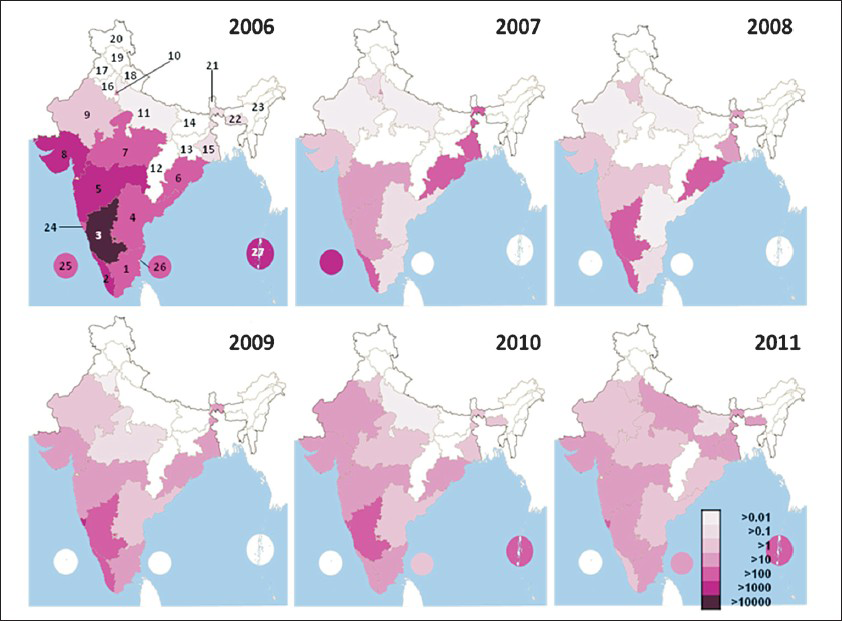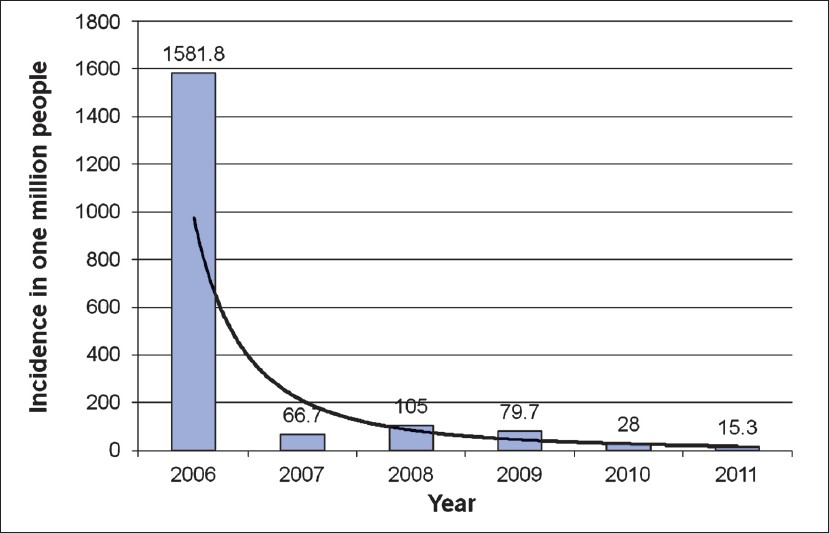Translate this page into:
Fading chikungunya fever from India: beginning of the end of another episode?
This is an open-access article distributed under the terms of the Creative Commons Attribution-Noncommercial-Share Alike 3.0 Unported, which permits unrestricted use, distribution, and reproduction in any medium, provided the original work is properly cited.
This article was originally published by Medknow Publications & Media Pvt Ltd and was migrated to Scientific Scholar after the change of Publisher.
Sir,
Chikungunya fever is an acute febrile illness caused by an arthropod-borne alphavirus, Chikungunya virus (CHIKV). The virus is primarily transmitted to humans by the bite of an infected Aedes species mosquito1. The CHIKV was first detected in southern Tanzania in 1952, after that the virus continued to circulate in West and East Africa at relatively low levels2. The spread of CHIKV throughout South and Southeast Asia, have occurred in three waves. The first wave of outbreaks occurred mainly in South Asian countries such as India and Sri Lanka during the 1960s and 1970s. In comparison, the second wave occurred over the 1980s and 1990s, in Southeast Asian countries, such as Philippines, Thailand, Myanmar and Indonesia. The most recent wave of outbreaks started in 2005 in South Asia. This wave was heralded by successive outbreaks in many islands of Indian Ocean in 2005 and subsequently, there was a massive outbreak of cases in 2006 in India which continued through 20103. After the first wave in 1973, the CHIKV had almost disappeared from India till the end of 20054. Despite affecting millions of people for more than half a century, the chikungunya fever has been neglected4. It has been suggested that the outbreak started in late 2005 was due to social and environmental changes in the affected countries and behavioural and biological changes in vector5. Hence it is important to know whether the chikungunya fever has become endemic or it occurs in epidemic form and then disappears as in the past.
In this report, the incidence of chikungunya fever per million populations was calculated for each affected States of India for the period from 2006 to 2011. The data were extrapolated in the map of India (Fig. 1) to determine the State-wise incidence. The overall trend of chikungunya fever in the affected States was also calculated for the period from 2006 to 2011 (Fig. 2). The population of unaffected States were excluded to get more accurate picture. The number of people affected by clinically confirmed chikungunya fever in each State of India was obtained from the National Health Profile of Central Bureau of Health Intelligence6 and the total population in each affected State for the same period was obtained from the Provisional Population Tables of Census of India7.

- Fading intensity of chikungunya fever from India. The coloured boxes indicate the incidence of chikungunya fever in one million people. Numbering in the first map indicates corresponding States described in the text. Legends: Tamil Nadu (1), Kerala (2), Karnataka (3), Andhra Pradesh (4), Maharashtra (5), Orissa (6), Madhya Pradesh (7), Gujarat (8), Rajasthan (9), Delhi (10), Uttar Pradesh (11), Chhattisgarh (12), Jharkhand (13), Bihar (14), West Bengal (15), Haryana (16), Punjab (17), Uttarakhand (18), Himachal Pradesh (19), Jammu & Kashmir (20), Sikkim (21), Meghalaya (22), North Eastern States (23) such as Assam, Arunachal Pradesh, Manipur, Mizoram, Nagaland and Tripura, Goa (24), Lakshadweep (25), Puducherry (26) and Andaman & Nicobar Islands (27).
-
Source: Ref. 6
The analysis showed that Karnataka (numbered 3 in the map) was the most affected State during the 2006 outbreak followed by the States which are in the western side of the country, facing the Arabian Sea, starting from Gujarat (8) to Kerala (2) through Maharashtra (5) Lakshadweep (25) and Goa (24). The States which face the Bay of Bengal starting from Tamil Nadu (1) to West Bengal (15) through Puducherry (26) Andhra Pradesh (4), Orissa (6) and Andaman & Nicobar islands (27) were comparably less (approximately ten-fold) affected along with Rajasthan (9), Madhya Pradesh (7), Uttar Pradesh (11) and Delhi (10). Excluding 2007, the Karnataka State seemed to be the hot spot for the chikungunya fever throughout the current epidemic. The three clusters of adjoining States were virtually free from the current outbreak. The first cluster included the northern States such as Punjab (17), Himachal Pradesh (19), Uttarakhand (18) and Jammu & Kashmir (20). The second cluster included the Chhattisgarh (12). The third cluster included, the entire North Eastern States (23) such as Assam, Arunachal Pradesh, Manipur, Mizoram, Nagaland and Tripura excluding Meghalaya (22). Although Jharkhand (13) and Bihar (14) were not affected till 2010, cases were seen 2011 (Fig. 1).
The overall trend shows that the incidence of chikungunya fever in one million people declined suddenly from 1581.8 in 2006 to 66.7 in 2007 (Fig. 2). This sudden decline seemed to be due to the alarming awareness created by the print and electronic media about the chikungunya fever and effective vector control and source reduction practices carried out by the concerned State Governments5. With a slight increase in 2008 to 105, the cases started declining to 79.7 in 2009, 28 in 2010 and then to 15.3 million people in 2011. The chikungunya outbreaks which started in the late 2005 in different States of India almost disappeared in 2011. This decline might be due to the effect of herd immunity8. Although this study is limited by the use of data collected by passive reporting, the number of cases reported for each year in the study period is assumed to be a fairly stable proportion of the actual number of cases.
Acknowledgment
The information provided by Central Bureau of Health Intelligence (http://cbhidghs.nic.in/) and Census of India (http://censusindia.gov.in/) is acknowledged. Author thanks V. Rajamannar, J. Nagaraj, R. Gopal, R. Sathish Babu and S. Vijayakumar for technical assistance.
References
- Chikungunya fever: an epidemiological review of a re-emerging infectious disease. Clin Infect Dis. 2009;49:942-8.
- [Google Scholar]
- World Health Organization. Outbreak and spread of chikungunya. Wkly Epidemiol Rec. 2007;82:409-15.
- [Google Scholar]
- Epidemiology and control of chikungunya fever in Singapore. J Infect. 2011;62:263-70.
- [Google Scholar]
- Emergence of chikungunya virus in Indian subcontinent after 32 years: a review. J Vector Borne Dis. 2006;43:151-60.
- [Google Scholar]
- Chikungunya epidemic: analysis of reports of a lay press. Ann Trop Med Public Health. 2008;1:25-8.
- [Google Scholar]
- Central Bureau of Health Intelligence. Available from: http://cbhidghs.nic.in/index1.asp?linkid=267
- [Google Scholar]






